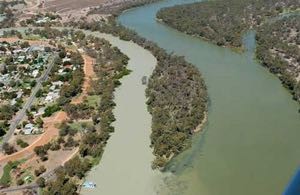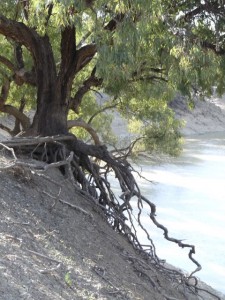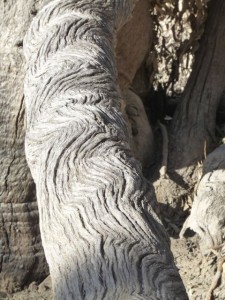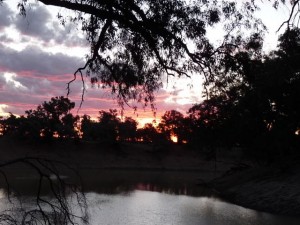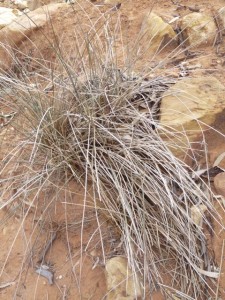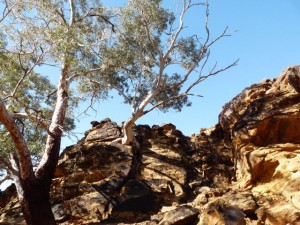Writing about place
The Nature Conservancy Australia holds a biennial nature writing competition with a focus on place/ landscape. I didn’t make the shortlist but my entry, based on travels in western NSW is here.
SOLACE
For people from the coast, and that’s most Australians, it takes time to know the wide spaces of the inland. To know through the senses and through the mind. To know in the way that we know the places that are familiar to us. Like the parks, shopping centres, playing fields and traffic jams of our existence.
The wide spaces can be confronting – environmentally, socially, spiritually. Acceptance of the difference, a sort of acculturation, can be beneficial in discovering the charms of the wide spaces. And in managing the repulse that’s to be found here.
My earliest years were in Adelaide. Growing up on a full acre block in the suburbs gave me a sense of space. The driest state in the driest continent hosts a stark and almost barren coast of muted colours. I left Adelaide long ago and have no social ties there, but on occasional visits the feel and, especially in summer, smell of the place is still familiar. Imprinted on my consciousness.
I now live at Jervis Bay, south of Sydney. This is a moist and verdant coast. Not far away, on the basalt soils, where pasture grasses thrive, like the black and white cows they support, it’s often so green it can hurt your eyes. The feel and smell of this place, particularly when the banks of seaweed rot or the thunderstorms approach or bushfire threatens, has become familiar. I know what it is to return here.
I don’t say that I know the wide spaces in the way I know these other homes I have had, but I’m curious. They’re becoming more familiar. I may be getting there. And in the wide spaces I feel easy.
*
From the shores of home we head west through thick forest country, far thicker than pre-European times. Before long we’re into woodlands and then extensively cleared agricultural lands before a night with friends Trevor and Lorraine in Wagga. Lorraine’s an aquatic ecologist and views about the politics of the rivers are never far away.
Deep in to winter, but sunny and mild the next morning, we head off around midday with first stop at Narrandera on the Murrumbidgee River. A 1950s collection of Aboriginal stories in an op shop, including one of Narran Lake, a place of special interest to friends in Walgett, is a pleasing op shop find. A 20 cent investment.
Big water in the Wiradjuri language, we’re following the ‘bidgee, in a fashion, as we continue west to the Hay Plain, now cool and drizzly. Boring to some eyes, enchanting to others, with its vast skies and wide vistas. A friend’s brother, having lived in Griffith and regularly crossed the plain once told me he couldn’t wait to get across. “It’s always the same. There’s never anything to see,” he complained. And until you get your eye in, to the subtleties of the plain, that’s how it remains for many.
Banjo Patterson, romanticist of the bush he may have been, had his eye in. Or at least he had a turn of phrase. “For those that love it and understand, the saltbush plain is a wonderland,” he wrote in 1891.
After a night in Hay, capital of the plain, we move on through Balranald still following the Murrumbidgee River, which joins the Murray River a little west of here.
Then onto Wentworth at the junction of Australia’s two biggest rivers, the Murray and the Darling. During the riverboat days Wentworth was the busiest inland port in NSW. Close to Mildura’s broader range of economic and social opportunities, this is a well-kept town with an air of prosperity. At least superficially, and that’s meant with no disrespect, just acknowledgement of what someone passing through can’t know.
To be at this point where the broad Murray meets the narrower Darling is to know something of Australia. Or to know there’s something different, something worth knowing. The Darling’s water is the colour of milky coffee, the Murray’s of stronger coffee. A noticeable difference, revealing the soil types they pass through and the flow rates.
We pitch our tent 20 kilometres out of town for a couple of nights at the lovingly cared for Fort Courage Caravan Park. Well grassed and shady it’s the veritable oasis in the desert. On the Darling River and owned by the Wentworth Anglers Club, caretaker Steve explains it takes its name not from any heroic efforts of early settlers, but from an advertisement made here for Courage beer in the late 1970s. Steve and Rayma have been here four contented years, after 20 years in a panel shop in Stawell.
This is the domain of the grey nomad, several with small canine companions. Friendly and welcoming we share their happy hour in the camp kitchen. Here conversation centres on football, of the AFL variety, and fishing, which has been good: plenty of yellow belly around, a few cod we hear. The dinner Meg cooks is a source of astonishment. “She said they don’t eat meat every night!”
The enduring memory is that people care for this place, familiar to many of them, and for each other, well acquainted as many are.
I’m presenting life story writing workshops as we travel and the first is in Wentworth. Wentworth and me is a starting theme on offer for writers to explore. Deep connections to the place are evident. That night some semblance of the normal order is restored to the Fort Courage camp kitchen as I cook beef. Vindaloo.
Next morning we visit the Perry Sandhills.[ii] Rising out of the surrounding saltbush plain these are the product of an ice age and thousands of years of wind erosion. One river red gum (Eucalyptus camaldulensis) grows in a dune with its trunk buried to the lower canopy. To walk around the canopy of such a tall tree, estimated to be around 500 years old, is an ethereal experience. Aptly, it is known as the God Tree.
Constantly shifting sand continues to give up the remains of extinct megafauna: giant kangaroos, wombats, emus and goannas. And extensive evidence of Aboriginal use of the land. Other uses are evident with cardboard sliding popular. Kids, and adults too I suspect, in nature. Outdoor recreation done simple. Music under the stars has been held here also, as part of an arts festival, until the weather was uncooperative once too often. I imagine a string quartet, or a didgeridoo, on a warm evening here on the slowly shifting sand with yet more secrets to be revealed.
*
North from Wentworth the bitumen finishes at Pooncarie a small village on the Darling. Settled in the 1840s, current population 50ish. The remains of the paddle steamer Rodney rest here. In 1894 striking shearers blockaded the river and forced scab labour off the Rodney as it headed upstream. For good measure they then burnt it. The west has a long history of worker revolt, militant unionism.
Heading north from Pooncarie, red sand contrasting with blue sky dominates.
A truck approaches, heading south. Then, a kangaroo cuts across the trucks path, appears to notice us and slides to a stop, momentarily losing its footing in the loose sand, before turning and heading back from where it came. Centimetres to spare. Heart in mouth for us, on the side of the roo, but how common this must be for outback truck drivers.
After Pooncarie comes Menindee, the first town established on the Darling, with a rich history well told in a heritage trail. Surely more interpretive signs per head of population than most other places. It’s from here that Burke and Wills set out for the Gulf of Carpentaria in 1860.
Nearby to Menindee, Kinchega Station was established in the 1850s, expanding to an area of more than 800,000 hectares in size and carrying 140,000 sheep at its peak. Little remains of the homestead, built on the banks of a billabong off the Darling. A few brick courses, a chimney. A cemetery is nearby. The site of the vegetable gardens is known. Self-sufficiency was necessary here, back then, and this story is well told. A stout but fading palm tree adds to the story. The wool shed, built in 1875, still stands. Solid river red gum construction. A little less than a hundred years after its establishment the station was abandoned. But not before six million sheep had been through. This is a place of imagination.
In the late 1960s Kinchega National Park was established over part of this land, on the western bank of the Darling and taking in some of the Menindee Lakes. These are a chain of lakes connected to the Darling via short creeks. A water storage scheme,[iii] completed in the 1960s, regulates several of the larger lakes for flood mitigation and storage. The storage scheme has a surface area of 47,500 hectares. Concrete spillways, vertical lift gates, massive rock walls. These are the engineering feats that control the water, bringing life and prosperity, but with no guarantee.
This is the unreliable majority of Broken Hills water supply as well as for the lower Darling and the Murray. All the way to Adelaide. We are of course in an area where evaporation generally exceeds annual rainfall.
Growing up in Adelaide I learnt early about water quality, but I didn’t know why it was as it was. Just that when we visited relations in Melbourne you knew the difference. It’s improved now of course. Better catchment management or improved water treatment? The latter I think.
The lakes are an attraction to many people, water in the desert being what it is. The small community of Sunset Strip, just out of Menindee town is testament to that. Largely self-sufficient and providing many of its own services, 120 odd houses sit on the lakes edge. Like living at the beach, even though the lake is sometimes bone dry.
I understand the delight they bring to sunset photographers, with their stark silhouettes, but dead trees lining the fringes of man-made lakes – regulated lakes to use the correct term – leave me cold.
*
With its source included the Darling, from its beginning in south-east Queensland, is Australia’s longest river. Excluding the source it becomes second longest, behind the Murray. This is a complex, meandering river system with associated lakes, billabongs, wetlands and anabranches.
Anabranch. A wistful name for a particularly Australian geographic feature, where a river section diverts from the main channel, rejoining downstream. The Great Darling Anabranch, now often dry, is the ancestral river course of the Darling, diverting south of Kinchega, rejoining at Wentworth.
Over time the Darling system has lost much of its wildness, becoming a river of regulation, a bit like a bank with withdrawals and deposits. Withdrawals of water through diversions, and suction pumps into storages. And receipts, of pollutants and salt. The regulation has bought economic prosperity to towns. Respectable pay packets. Of course there’s two sides to every coin. Benefits come with costs.
Natural variations in annual flow compound the situation. In 1991, during drought and with virtually no flow, more than a thousand kilometres of the Darling were stricken with a blue-green algae outbreak. Not safe for stock, dogs, wildlife or people, this was a world record. Only with rain flushing the river did the problem abate. The solution to pollution is dilution.
Astonishingly, variability in the flow of the Darling is more than 300 times that of the Murray.[iv]
We’re deep into what’s been called the anthropocene, an epoch where humans shape the planet. So it’s reassuring governments have algal management strategies. Balancing actions that deal with the symptoms and those that deal with the cause. So it’s said.
*
To sit on the riverbank above the Darling, Barka to afford it the name by which it’s known in the Aboriginal Barkindji language group, is to invite contemplation. Barka. Barkindji. Depending on where you are, or who you are, the Barkindji may be the Paakantji. And then the Barka will be the Paaka.
Two or more organisms closely co-existing in a long-term relationship, which may – but not necessarily – benefit each is known as symbiosis. Microbes in the human gut and small cleaner fish on large predatory fish are a couple of examples. People and a river that supports them may be another.
Either way the connection of Aboriginal people to country is clear. Aboriginal occupation of the area dates back at least 36,000 years. Not far away at Lake Mungo, Aboriginal remains in ritual burials – Mungo Lady and Mungo Man – have been dated at more than 40,000 years. Plenty to contemplate.
When treated with respect Aboriginal people often established cordial, helpful relations with early explorers. When treated with disdain relationships were tense, or worse. Later, when Europeans arrived, Aboriginal dispossession was swiftest along the rivers as the invaders laid claim to the surrounding land, forcing an end to the Aboriginal existence as hunters, fishers and collectors. As in other places Barkindji resisted for a time. Terrible things happened as Aboriginal stewardship of land, based on observation and experience was replaced by an economic system based on ownership and exploitation.
One Night the Moon is a musical film, almost operatic, about a white child lost in the Australian outback in the 1930s. The child’s father resists the offer of help from local Aboriginal people who know the land. It ends badly, for the child and the father. Singer songwriter Paul Kelly plays the father, singing at one point, “This land is mine.” Aboriginal actor Kelton Pell, who plays the part of a scorned black tracker sings, “This land is me.”
*
On the Barka the river red gum is the dominant tree. This is the most widely distributed of the Eucalypts, found on inland rivers throughout mainland Australia it commonly grows to 30 metres and may reach 45 metres. In the dry watercourses, where it survives on underground water and irregular flooding, it grows much lower. It can live to more than 500 years, perhaps 1,000 years.
In the river red gum forest a regular but slow scrape, scrape of large branches rubbing in the canopy is pervasive. It’s earned a name as a widow maker through a propensity to drop branches without warning. Most commonly on hot still days, not the windy days our faulty logic tells us. I haven’t heard it, but the crack of the tear followed by the deep thump of a branch hitting the ground is said to reverberate on those hot still days. I can imagine it.
But not all snapped branches hit the ground, many wedging in the canopy. Scrape, scrape. On the Darling River in Kinchega National Park we pick our tent site with an eye above.
In mostly evergreen Australia the first Europeans noted trees that shed their bark, rather than their leaves. A mystery to understand. Or not. Here in the river red gum forest strips of shed bark crunch underfoot.
Aboriginal canoe trees are to be found here. When, I wonder, was the last canoe made from here.
River red gum’s name comes from the timber. The smooth bark of standing trees varies from white through grey, often darker and rough textured at the base. Fallen branches lose their bark, sometimes, eventually perhaps, revealing a complex pattern of curvilinear lines, redolent of Aboriginal carved trees, the dendroglyphs, found further east. But this is the product of weathering. Many years of weathering.
Branches fallen into the river become snags. Many were removed long ago for riverboat access. But eighty per cent of Murray Cod are found within one metre of a snag and re-snagging now takes place in some areas. Fish numbers, apart from the rabbit of the rivers, the carp, are well down.
A tangle of exposed roots on the dry, cracked, bare earth of the riverbanks. Like jungle ropes. But high on the bank, few making it to the water. Why so I wonder.
Water the colour of a latte, but deeply reflective.
Here in Kinchega, on the Barka, the early morning bird symphony is different to home. It’s gentler, a magpie warble, chittering honeyeaters, various whistlers and peepers before the screechers join in. At home it starts Kookaburra, and as I write in early summer, the mournful Koel.
Willie wagtails, working in tandem, relentlessly harass a solitary raven. Cockatoos in flocks, raucous anytime, especially sunset, nesting in tree hollows. The elongated, skittering, landing splash of a pelican – Pelicanus conspicillatus – conspicuous wherever it travels. Paddling steadily below. Serene and statesmanlike above.
At lock 32 the waterbirds stand, sentinel like, aside the shallow rocky passage. An occasional flurry of activity when a fish passes by.
When disturbed the grey kangaroo thumps away, as they do everywhere. Brushtail possums quarrel at night, as they do everywhere. Away from the river, emus rule the saltbush and grassland plane. Almost imperious, not quite.
Sky, often clear all day, musters up some late afternoon scalloped cloud to put on an enhanced sunset. A glimpse of starlight through the canopy.
These are the sights and sounds of this place and its laconic, concise sort of energy.
*
Brian Wattchow[v] writes of wounded rivers and our relationship to them. The river, he says, “becomes interpreted as a conduit for a commodified water resource, a damaged and imperilled ecology, an object in need of our environmental management skills. The river becomes a place of loss, a place in decline.”
A wounded river of course, sits in a wounded landscape.
A river is like a mirror: it reflects the care given by people whose lives depend upon it. A scald on red ground or the slow death of a river reveals more than troubled ecological relationships – they are signs of broken social relationships. How people take care of social relationships and how they take care of ecological relationships are the same question.[vi]
Social relationships and ecological relationships – the same question. Wounded river, wounded landscape, wounded people.
But despite the wound solace is to be had here.
Australian environmental philosopher Glenn Albrecht has developed two terms to describe human feelings about place. Soliphilia is the love of and responsibility for a place,
bioregion, planet and the unity of interrelated interests within it. Solastalgia is the pain experienced when there is recognition that the place where one resides and that one loves is under immediate assault.
Here in this place – where I’m only staying a while – I feel both soliphilia and solastalgia. In abundance.
*
“Thank God for plastic,” remarked the driver of the car behind us as we surveyed the crumpled moulding that used to be known as a bumper bar. “Could have been much worse.” Indeed it could have.
We check the roo, that had come from nowhere, doesn’t have a joey. If so we’re faced with limited options. A couple of weeks later in a writing workshop at White Cliffs, Shirley Meyer offers a perspective when there are no options.
Early morning. The way the light hits the gibber and vegetation; all with halos. Perfect. Two very active ears above the smooth grey belly. Stop the car. What a way to start the day – ending that potential with one swift swipe of the shovel. Not so perfect anymore.
Our roo was minus joey.
I ask the wildlife rescue people in Broken Hill[vii] to estimate the numbers of road kill in the vast area they cover. Unable to hazard a guess, but in the dry years its huge, Denise tells me. “Sometimes you can barely go a few feet along the road without coming across a dead kangaroo,” she says. But in the wet years, when there’s plenty of feed, very few.
The dry years are frequent here.
*
Leaving our camp on the Barka and heading west the Barrier Range comes into view. A low and narrow broken rise, running north south, given prominence by the flatness of the plains either side of it. The flatness of the plain is noted in a geography textbook first published in 1912. [viii]
Beyond Dubbo [550 kilometres east as the crow flies] the Great Plains slope about two feet per mile to the Darling, beyond which they rise again at the same rate towards the north-western boundary of the colony.
The same textbook notes the Barrier Range, although being fairly well defined, is “of no great extent or elevation.” I had thought it more impressive than that.
Arriving in Broken Hill the wide awnings and handsome buildings are well familiar. The history of worker revolt and militant unionism runs deep here. It’s concentrated in Trades Hall but conspicuous in outdoor murals on prominent buildings. It’s the story of the trade unions, along with the pastoral and mining industries, all captured in artistic responses that underlie the cities claim to heritage listing.
After a writing workshop in Broken Hill library I overhear and then join a conversation between two old fellows.
“Wasn’t it warm yesterday?”
“Yea, and July’s our coldest month.”
“We’ll be paying for it when summer comes.”
“Do you think it’s climate change?”
“Nah, just the seasons, none of that greenie rubbish.”
“Dunno, but something’s changed, something’s going on.”
They had settled at a table I had previously occupied alone and, as we had exchanged pleasantries, this emboldened me to join their conversation. “What do you base that on?” I enquired as politely as I could.
“When you’ve lived around here as long as I have – I was born here and I’m over 80 – you notice these things.”
“Would you say you believe the science of climate change?” I ask.
“Well you’ve got to believe something,” he replies, with a hint of providence, as his companion stifled a scoff.
*
In December 1844 Charles Sturt, in his search for the inland sea, left the Darling River and crossed a narrow section of plain to the Barrier Range near Fowlers Gap, 110 kilometres north of Broken Hill. Sturt’s travels were impeded in places by the density of white pine (Callitris columellaris) and possibly mulga (Acacia aneura). At Fowlers Gap the white pine is now all gone. Mulga is sparse.
Pastoral runs were established in the Fowlers Gap area in the 1860s. To bring some flexibility to lease conditions the Crown Lands Act of 1884 saw pastoral runs divided into two forms of tenure. Leasehold areas were of 15 years with an option of another five years. Resumed Areas were just one year. Naturally enough energy and investments went into the longer leases. Because of the investment there was an imperative to maximise returns from these areas. The land in many cases was flogged to death. On the annual leases, with no incentive to invest, the land was just flogged.
The Fowlers Gap Arid Zone Research Station was established by the University of New South Wales in 1966.[ix] This is 39 hectares within a working sheep property of 38,000 hectares that makes a handy income from harvesting feral goats while hosting research into arid lands ecology and management.
During a week at Fowlers Gap several memorable conversations were had with (then) Research Station director Keith Leggett. Keith had done his PhD in marine biology before working on large mammal conservation (think elephants, giraffes) in Africa. Now at Fowlers Gap, small mammal research was his focus. Keith said during the 1880s and 90s an estimated 40,000 trees were removed from the Fowlers Gap run for fencing and construction.
Feral cats, foxes and goats are the major pests, in that order, Keith says. Goats are the main problem for vegetation, cats the main problem for wildlife. Keith had recently shot a cat that reached knee height. Cats, like all mammals, can change their size in response to environmental conditions. More food equals increase in size, less food equals decrease in size. “Won’t be long,” he says, “before they’ll be panther size out here. At that stage they’ll take out goats and sheep and be a threat to joeys.”
Around the station river red gums lay claim to the larger creeks, belah (Casuarina cristata) the smaller creeks. Most of our week is in a cottage in a remote gorge on the property.
Stunning in its location, stunning in its silence, here colour and texture dominate the senses.
Pale and well-spaced spiny sedge (Cyperus gymnocaulus) lines the dry, rocky watercourse. Curly Mitchell grass (Astrebla lappacea), tightly coiled, pubescent-like.
White and grey bark of river red gum, growing low in the watercourse. Others directly in the rock of the gorge wall. Some with masses of rounded protrusions known as burls at the base. Typically Australian grey-green shades of the canopy.
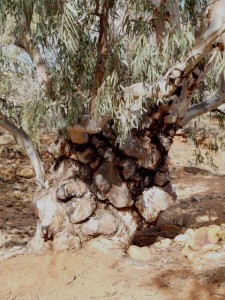
The rock of the gorge, shades of red and cream with darker streaks, and the blue sky, barely troubled by any cloud. These are the images imprinted in my mind.
Sunrise comes slowly over the vast plain below the hill behind our cottage, spreading down the hill in front of us. At night we watch Venus set, in a blanket of stars, with the occasional satellite. All in silence.
There are few trees on the plain and the rocky hills now, mainly scattered Acacia and Eucalypt.
Aged fence posts stand sturdy, running for miles over the plain and the hills. The only reminder of the long gone stands of mulga that I try to imagine. And the pine that had once embraced and held together the sandy plains. The suite of native animals that lived here, greatly diminished.
But still many kangaroos and many, many goats. Shortly before our stay 3,000 goats had been mustered from this area of the station and sent to market.
This too is a wounded landscape. A starkly, serenely beautiful wounded landscape, but here too, solace is to be found.
*
From here we travel north along the Silver City Highway, much of it unsealed elegance.
Wedge-tailed eagles feast on roadkill.
Milparinka township, now virtually deserted, except for a visitor centre staffed by volunteers who come for a week at a time. Gold was discovered near here in the 1880s. Charles Sturt passed through and, finding water at Depot Glen, set up camp for six months waiting out drought. Sturt had his men build a cairn atop a nearby hill, Mt Poole, “to give the men occupation: and to keep them in good health.”
Tibooburra township is next and then Sturt National Park with its myriad landforms: gibber plains, pale sand dunes, red soil in the inter-dune spaces, Lignum swamp, flat top mesas and Jump Ups rising abruptly from the plains.
After this, White Cliffs where opal provides a hobby for many. Only those who value-add can hope to make a living from it. This is a heritage-mining site with restrictions on the size of machinery to prevent large operations moving in. But people stay, or keep coming back for the cooler months. The roo shooters wife talks of the anguish they felt when they had been forced to move away during drought. No roos to shoot.
And Wilcannia, a broken jewel of sandstone heritage where a nurse talks about the night before at the hospital. Worst abuse and threats she had seen in more than 20 years. Wounded people in a wounded landscape. A place where the grey nomads tell each other not to stop, definitely don’t stay. But Chris Elliott and her husband Bill who have lived here all their married lives, and who hosted my writing workshop, opened a coffee shop a couple of years before. “To do something for the town,” Chris says, with determination. Other new arrivals, from Canberra, have opened an art gallery.
Then along the Darling, through tiny Tilpa and Louth to Bourke, a town with people from 22 Aboriginal language groups. Described in a media report from early 2013 as the most dangerous place in the world, it has it’s problems, but the town feels better, is better, than it has been in the not too distant past.
And on to Brewarrina, with its 40,000 year old fish traps on the Barwon River, before, finally, Walgett where we present the 20 cent book from Narrandera. Outback NSW Tourism markets a road trip between Walgett and Wentworth as the Darling River Run. In the cooler months it’s popular. On many a grey nomad’s bucket list. To do it justice takes time.
In a paper he co-authored Bourke Aboriginal elder Phil Sullivan[x] says:
The environment is a reflection of who we are as human beings, and the environment is in a crappy way. And you know why it’s in a crappy way? Because we’re in a crappy way. That’s the bottom line. The environment is terrible. The river is terrible. The water’s still there, but the river’s terrible. And it’s in a crappy way because we as a people are in a crappy way.
*
Write what you know, is a writer’s maxim, drawing on life experiences to craft a tale. But I often write to understand, to make sense. To find out what I know. I started this essay knowing I had something to say, uncertain what it was, but confident I would find its rhythm through the writing process. Through the imagination and contemplation that goes with it.
I imagine how beautiful it would be to see the land, the rivers and the people restored. The solutions to environmental problems are mostly known. They are in fact political problems. Restoring people, communities, will take trust and goodwill. This must be rebuilt not just from the top down, but at all levels of society.
I am both charmed and repulsed, but still find abundant solace in the wide spaces, different to that found on the crowded coast. My senses are fully alert, my curiosity is at its peak. And what I know with certainty is that in the wide spaces I feel easy.
References
Patterson, A B (1891) “In the Droving Days”, included in The Man from Snowy River and Other Verses, Angus & Robertson
[ii] Perry Sandhills: http://www.geomaps.com.au/scripts/perrysandhills.php
[iii] Department of the Environment, “Menindee Lakes Project,” http://www.environment.gov.au/water/rural-water/srwui/menindee-lakes
[iv] Robin, Libby (2007) How a Continent created a Nation, UNSW Press, Sydney, pp. 154-155
[v] Wattchow, Brian “River songs: A poetic response to Australia’s wounded rivers,” in F. Vanclay, M. Higgins & A. Blackshaw (eds) Making Sense of Place: Exploring concepts and expressions of place through different senses and lenses, national Museum of Australia Press, 2008, p. 47.
[vi] Muir C, Rose D, Sullivan P (2010 From the other side of the knowledge frontier: Indigenous knowledge, social–ecological relationships and new perspectives. The Rangeland Journal 32, 259–265 http://dx.doi.org/10.1071/RJ10014
[vii] Rescue and Rehabilitation of Australian Native Animals Inc
[viii] Taylor, J M (1927) Geography of New South Wales, Angus & Robertson Sydney Seventh edition
[ix] Mabbutt, J A (1973) “Historical Background of Fowlers Gap Station,” in Lands of Fowlers Gap Station New South Wales. Fowlers Gap Arid Zone Research Station Research Series No. 3. University of New South Wales, Sydney
http://www.fowlersgap.unsw.edu.au/sites/default/files/fg%20history.pdf
[x] see vi above
Photos
Photo of Murray Darling junction from Murray-Darling Basin Authority, all others mine.
